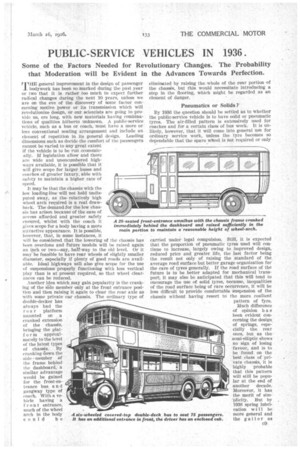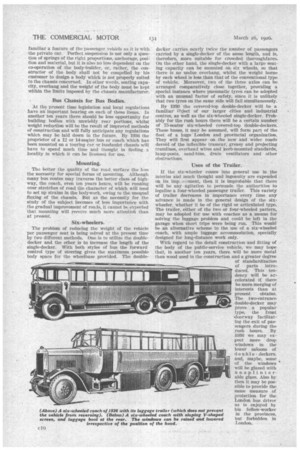PUBLIC-SERVICE VEHICLES IN 1936.
Page 15

Page 16

Page 17

If you've noticed an error in this article please click here to report it so we can fix it.
Some of the Factors Needed for Revolutionary Changes. The Probability that Moderation will be Evident in the Advances Towards Perfection.
THE general improvement in the design of passenger bodywork has been so marked during the past year or two that it is rather too much to expect further radical changes during the next 10 years, unless we are on the eve of the discovery of some factor concerning motive power or its transmission which will revolutionize design, or our scientists are going to provide us, ere long, with new materials having combinations of qualities hitherto unknown. A public-service vehicle, such as a bus or coach, most have a more or less conventional seating arrangement and include an element of repetition in its general design. Leading dimensions such as decide the comfort of the passengers
cannot be varied to any great extent if the vehicle is to be Tureeconomically. If legislation allow and there are wide and unencumbered highways available, it is possible that it will give scope for larger buses and coaches of greater luxury, able with safety to maintain a higher rate of speed.
It may be that the chassis with the low loading-line will not hold undisputed sway, as the-relatively high wheel arch required is a real drawback. The demandlor the low chassis has arisen because of the ease of access afforded and greater safety en.sured, whilst with the coach it gives scope for a body having a more attractive appearance. It is possible, however, that, in some instances, it will be considered that the lowering of the chassis has been overdone and future models will he raised again an inch or two—say, half-way to the old level. Or it may be feasible to have rear wheels of slightly mailer diameter, especially if plenty of good roads are available. Ideal highways will also 'give scope for the use of suspensions properly functioning with less vertical play than is at present required, so that wheel clearances can be reduced.
, Another idea which may gain popularity is the cranking ot the Side member only at the front entrance position and then raising it again to clear the rear axle as with some private car chassis. The ordinary type of double-decker has
always had the rear platform mounted or a cranked extension of the chassis, bringing the platform " approximately to the level of the latest types of chassis. By (-Tanking down the side member of the frame behind the dashboard, 'a similar advantage would be gained for the front-entrance bus, and gangway type of c.oach. With a vehiele having a f vont entrance, much of the wheel eliminated by raising the whole of the rear portion of the chassis, but this would necessitate introducing a step in the flooring, which might be regarded as an element of danger.
Pneumatics or Solids ?'
By 1936 the question should be settled as to whether the public-service vehicle is to have solid or pneumatic tyres. The air-Mled pattern is extensively used for coaches and for a certain class of bus work. It is unlikely, however, that it will come into general use for ordinary service work, unless the tyre becomes so dependable that the spare wheel is not required or only
carried under legal compulsion. Still, it is expected that the proportion of pneumatic tyres used will continue to increase, largely owing to improved design, reduced price and greater life, the last factor being the result not only of raising the standard of the average road surface but better garage organization for the care of tyres generally. If the road surface of the future is to be better adapted for mechanical transport, it may also be anticipated that this will tend to encourage the use of solid tyres, because, inequalities of the road surface being of rare occurrence, it will be less difficult to provide comfortable suspension of the chassis without having resort to the more resilient
pattern of tyre. Much difference of opinion h a s been evident concerning the design of springs, especially the rear ones, but as the semi-elliptic shows no sign of losing favour, and is to be found on the
n best class of pri vate chassis, it is highly probable that this pattern will still be popular at the end of
another decade. Moreover, it has the merit of sim'plicity. But by 1936 spring lubrication will be more general and the gaiter as
familiar a feature of tile passengervehicle as it is with -the private car. • Perfect .suspension is not only a question of springs (if the right proportions, anchorage, posi. , tion and material, but it is also no less dependent on theco-operation of . the body-builder, or, rather, the . constructor of the body shall not be compelled: by his customer to design a body which is not properly suited to the chassis concerned: In other words, seating capacity, overhang and the weight of the body must be kept within the limits imposed by the chassis manufacturer.
Bus Chassis for Bus Bodies..
At the present time legislation and local regulations have an important bearing on each of these items. In another ten years there should be less opportunity for building bodies with unwieldy rear portions-, whilst weight reduction will be the result of improved methods of construction and will fully anticipate any regulations which may be laid down in the future. By 1936 the proprietor of a 12 or 14-seater bus or coach .which has been mounted on a touring car or landatdet chassis will have to spend much time and thought in finding a locality in which it can be licensed for use.
Mounting.
The better the quality of the road surface the h:ss the necessity for Special forms of mounting. Although many bus routes may traverse the better class of highway, the coach, even ten years hence, will be running. over stretches of road the character of which will tend to set up strains in the bodywork, owing to the unequal flexing of the chassis. But as the necessity for the study of the subject becomes of less importance with the gradual improvement of roads, it cannot be expected that mounting will receive much more attention than at present, • Six-wheelers.
The problem of reducing the weight of the vehicle per passenger seat is being solved at the present time by two different methods. One is to utilize the doubledecker and the other is to increase the length of the single-decker. With both styles of bus the forward control type of steering gives the maximum possible body space for the wheelbase provided. The double
decker carries nearly twice the number of passengers carried by a single-decker of the same length, and is, therefore, more suitable for crowded thoroughfares. On the .other hand, the single-decker with a large seating capacity can be mounted on six wheels, so that there is no undue overhang, whilst the weight borne by each wheel is less, than that of the conventional type of vehicle. Moreover, two of the three axles can be arranged comparatively close together, providing a special instance where pneumatic tyrea can.be adopted with an unusual factor of safety, since it is unlikely that two tyres on the same side will fail simultaneously.
By 1936 the covered-top double-decker will be a familiar object of our larger cities and industrial centres, as well as the six-wheeled single-decker. Probably for the rush hours there will be a certain number of 75-seater six-wheeled covered-top double-deckers. These buses, it may .be assumed, will form part of the fleet of a huge London and provincial organization. They will first appear on the new and wider roads devoid of the inflexible tramcar, greasy and projecting tramlines, overhead wires and kerb-mounted standards, lamp-posts, sand-bins, drain ventilators and other obstructions.
Uses of the Trailer.
If the six-wheeler collies into general use in the interim and much thought and ingenuity are expended on its imp_ •J,-ernent, then it is improbable that there will be any agitation to persuade the authorities to legalize a four-wheeled passenger trairer. This variety of trailer decreases in importance every time any advance is made in the general design of the sixwheeler, whether it be of the rigid or articulated type. The trailer, either of the two or four-wheeled pattern, may be adopted for use with coaches as a means for solving the luggage problem and could be left in the garage when short trips were being run. This would be an alternative scheme to the use of a six-wheeled coach, with ample luggage accommodation, specially designed for long-distance work only.
With regard to the detail construction and fitting of the body of the public-service vehicle, we may hope that, in another ten years, there will be more metal than wood used in the construction and a greater degree of standardization of parts introduced. This tendency will be accelerated if there be more merging or interests than at present obtains. The two-entrance double-decker may prove a popular type, the front doorway facilitating the exit of passengers during the rush hours. By 1936 we may expect more drop ,windows in the lower saloons of double deckers, and, maybe, some of the windows will be glazed with unsplinterable glass. Also by then it may be Dos.sible to provide the same measure of protection for the London bus driver as is enjoyed by his fellow-worker in the provinces, but forbidden in London.
The typical coach body of 1936 will be of the central gangway type. Twill curtains, either rigid or nonrigid, with celluloid windows, will have given place to metal-framed drop windows. As progress in nearly all means of transportation is towards larger units, it is improbable that the coach of 1936 will be any narrower ; consequently, the hood problem will still be engaging the earnest thought of inventors. The hood which slides at the level of the top of side windows appears to be the pattern most likely to survive. But with the increasing re4nement of the body having a fixed roof and well-contilolled and adequate ventilation, the bus will prove a serious rival to the open style of vehicle. This is an age of electricity, and, maybe, the coach will gain increased popularity owing to the introduction of an electrically controlled hood and windows, together with a device whereby the locking of the doors is dependent on the operation of a switch.
Legislation and Progress.
The future development of the bus and coach is dependent to some extent on the legislation which may be enacted during the coming years. Much could be done if bodies could be built wider, say another 6 ins., or if 2 ft. 4 ins, were made the minimum length between rows of seats instead of 2 ft. 2 ins. A gain of another ins, added to the existing 1 ft. 4 ins, of length of seat per passenger would be a great gain in comfort. When the passenger is threading his way with difficulty along the gangway of a crowded omnibus it is natural that he should blame the bus company for not making the vehicle wider. But the utmost is made of the 7 ft. 2 ins. or 7 ft. 6 ins. available. This is all that the authorities feel they can allow under existing conditions of roadway width. The root of the trouble is that our general system of highways was designed for comparatively slow and small vehicles,


























































